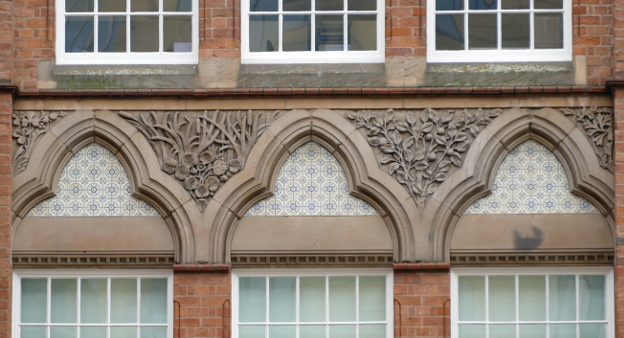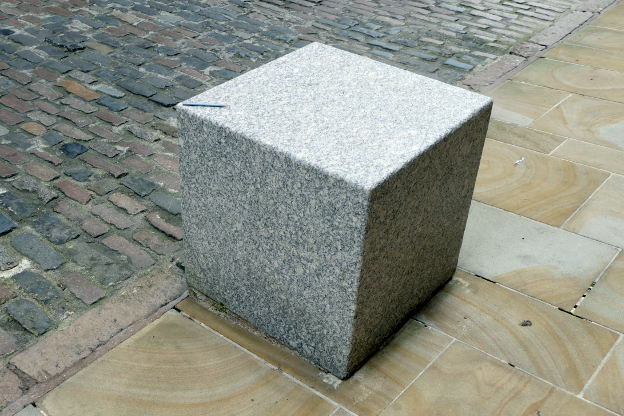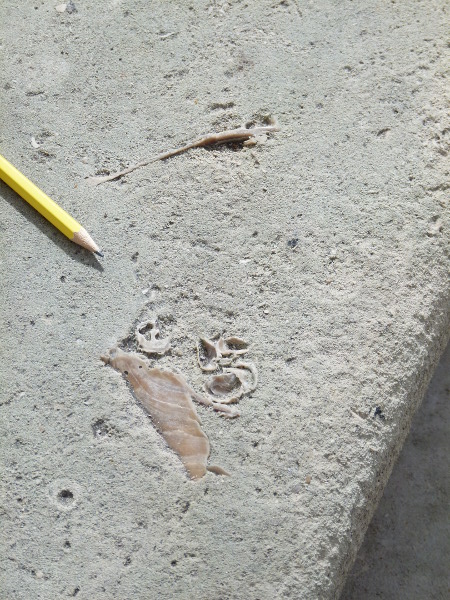Birmingham Building Stones Trails
Trail 2: Centenary Square to Brindleyplace continued
Continue along Broad Street until you reach One Brindleyplace on the corner of Oozells Street.
12. One Brindleyplace
This building marks the entrance to the Bridleyplace/Oozells Square development and was formerly occupied by Deutsche Bank. It was designed by Anthony Peake Associates and constructed between 1994-5. The main geological interest is the paving under the colonnade on the ground floor. A medium-grained to gritty, pale brown sandstone has been used for flagstones. It shows good examples of current cross-bedding and there is a high carbon content, both as disseminated material and larger fragments of plant fossils.
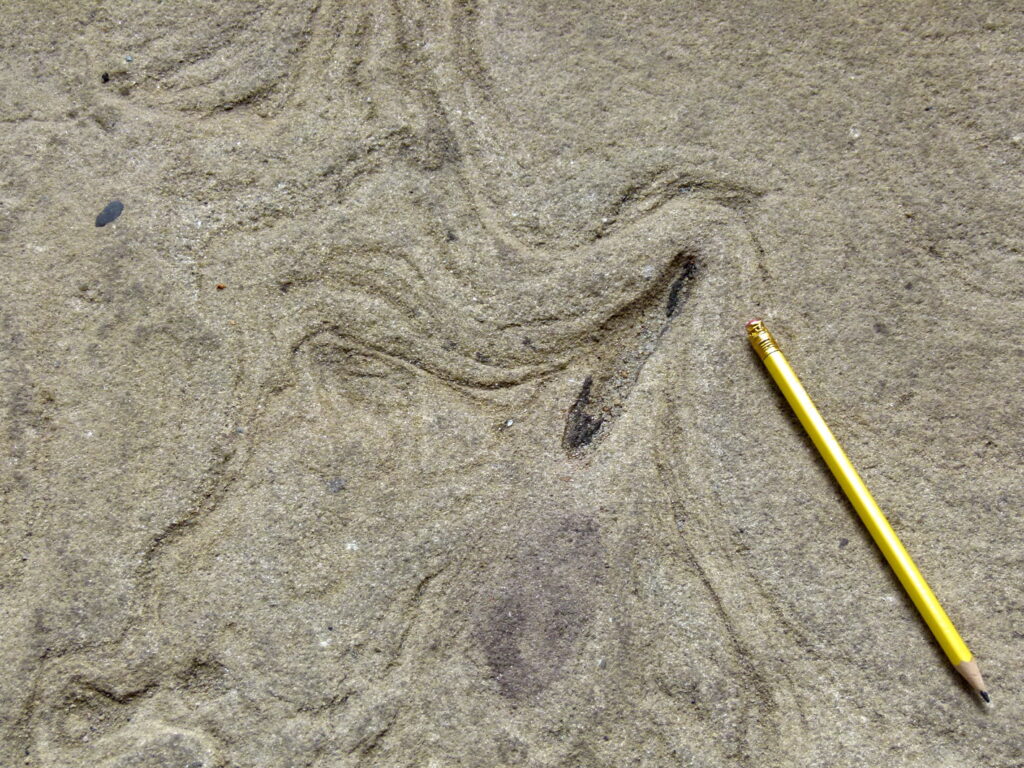
Convolute laminations and black plant debris at One Brindleyplace.
Follow the colonnade along Oozells Street to Oozells Square.
13. Oozells Square
The square has been remodelled as part of the Brindleyplace redevelopment under the direction of Townshend Landscape Architects. The centrepiece of Oozells Square is a sculptural installation by Paul de Monchaux (1998) called Water Feature. This is composed of six granite benches and a granite arch. A rill cuts diagonally across the square and this installation is surrounded by cherry trees. De Monchaux has an especial interest in stone and the materials he uses are integral to his work. The seven sculptures here are constructed from De Lank Granite from St Breward in Cornwall. It is a two-mica granite from the Bodmin pluton (297Ma) and has a characteristic ‘silver-grey’ appearance. De Lank is the only remaining quarry in the Cornubian Batholith still extracting dimension stone.
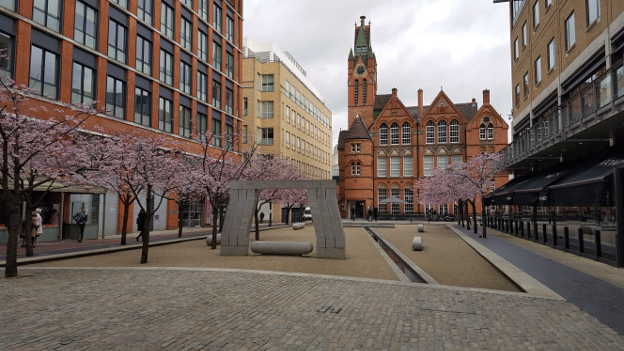
Oozells Square
The new office developments in Oozells Square and Brindleyplace are mainly brick built, reflecting the construction materials of the factories, workshops and warehouses which once stood here. One building of that time has been preserved and that is the old Oozells Street School designed in a very Birmingham version of the Victorian Gothic style by architects Martin & Chamberlain and completed in 1877. It has subsequently been restored and refurbished by the firm Levitt Bernstein and since 1997 it has been the Ikon Gallery. This phase of redevelopment reinstated the tower (designed to the original plans) which had been removed in the 1960s. Stone is used as dressings associated with the windows. Beautifully carved foliage can be seen in the gaps between the window arches on the second register. Again the stone is unknown. It is a dark brown-red in colour and could be one of the Triassic sandstones of the Midlands or the North of England.
The paving here continues to be of geological interest. Although much of the square is covered in gravel, reclaimed cobblestones have been used in patches and a good place to look for them is where the Oozells Street walkway leaves Oozells Square heading towards Brindleyplace. A wide variety of stones were used for cobbles during the 18th and 19th centuries and quarry industries were built up around the supply of cobbles and kerbstones for the growing networks of city streets. The granites of Jersey and diorites of Guernsey were primarily used for this purpose. Closer to Birmingham, igneous rocks quarried in the Black Country and the east Midlands were also commonly used. The origins of all the stones seen here are not possible to determine, especially the granites, but the characteristic features of the main stones used are described below.Mountsorrel Granodiorite comes from Charnwood in Leicestershire, geologically from the Ordovician intrusions of the Mountsorrel Granodiorite Complex. It is a medium-grained granite, with zoned, red and white feldspar, hornblende, quartz and biotite. The quarry – one of the largest in Europe – is still worked today for aggregate.
Markfieldite also comes from the Charnwood area of Leicestershire, but is derived from the suite of Neoproterozoic South Charnwood Diorites. It is quarried at Cliffe Hill, Markfield and Groby Quarries. It has a very distinctive appearance, a medium-grained diorite, speckled red and green. It is composed of green hornblende and pink orthoclase, with minor epidote appearing as bright green patches. It is commonly seen as cobblestones along with Mountsorrel Granodiorite.
Rowley Rag is a local whinstone that was used for cobbles. It is derived from a series of quarries, known as ‘The Quacks’ around Rowley Regis in the Black Country and comes from the Rowley Regis Microgabbro (dolerite) which is a small lopolithic intrusion which forms part of the Late Carboniferous Brierley Hill Cluster of intrusions. It is a fine-grained olivine dolerite. It is difficult to distinguish from other varieties of Whinstone, but it is dark grey with, sometimes, a brownish patina. It was widely used for cobblestones in Birmingham and surrounding areas but developed a reputation for acquiring a polish which caused horses to skid and therefore went out of use.
Trefor Granite is from North Wales. Like Mountsorrel and Markfieldite, it was mainly quarried for cobblestones, but had the added value of being one of the few stones with the perfect properties for making curling stones (it was the chosen source for the Salt Lake City Winter Olympics stones). There are two varieties of Trefor Granite, a dark grey variety and a pink-pale grey variety. Both have abundant, small, white plagioclase phenocrysts. Both stones are quarried at Trefor on the Lleyn Peninsula from separate intrusions in the 450Ma Garnfor igneous complex.

Reclaimed cobbles in Oozells Square. Dark grey cobbles are Whinstones, and some may well be Rowley Rag. The three pale grey and pink stones at the top right are Trefor Granite. The two red stones are Mountsorrel Granodiorite.

Pebble line marking the edge of a channel
14. Six Brindleyplace
Dating from the early 1990s, the buildings of Brindleyplace are dominated by brickwork, but look down, and the paving reveals a feast of geology. This walkway belongs to Six Brindleyplace, and is paved with York Stone similar to number One, but here showing more striking sedimentary features.
The stone is a very coarse-grained sandstone showing a wide variety of grain sizes, including small pebbles. These have been sliced through to make a level surface. Curved boundaries mark the edges of channels where the sediment was deposited. Many slabs show current cross-bedding. The dramatic sedimentary structures here are evidence of a fast flowing river with many channels, possibly caused by episodes of flash flooding.
15. Brunswick Street
Brunswick Street is mainly used for taxi access to the Central Square of Brindleyplace. It is cobbled with red, reclaimed cobblestones which are predominantly Mountsorrel Granodiorite, with the occasional block of Markfieldite and Whinstone, as described for Oozells Square above.
York Stone is used for the pavements, this is an example with spectacular Liesegang banding, a form of iron staining produced through a series of complex chemical reactions in ground waters percolating through the rock. These flags are derived from a series of quarries in the Upper Carboniferous Pennine Lower Coal Measures Group.
Granite cubes are used for street furniture. Unfortunately the provenance of these stones is unknown but it is possible that they have come from either the Iberian Peninsula or China, these areas being the main suppliers of granite to the UK building industry. It is very similar to the ‘Alpendurada’ granite from NW Portugal used for steps and seating in the more recent development of Chamberlain Square (see Trail 1), so this may be the most likely source. It is a grey medium to coarse-grained granite with brick shaped phenocrysts of pale pink potassic feldspar, in a matrix dominated by grey quartz and white feldspar.
Turn back and follow Brunswick Street into Central Square.
16. Central Square, Brindleyplace
Planning for the development of Brindleyplace, which encompasses the large Central Square, Oozells Square and Brunswick Square began in 1987. The City Council invited developers to bid for a scheme based on commercial, leisure and cultural opportunities and to open up the canals as areas for waterside activities. However, the site changed hands a number of times and is currently owned by Hines Global REIT. Planning permission was obtained in 1992 and building began on 6th September 1993. The architects for the complex were Porphyrios Associates, Allies & Morrison, Stanton Williams and Siddell Gibson, with Townshend overseeing the landscape architecture of the open spaces. As brick dominates as the main material used for the buildings, we will focus on the square and its fountain.
The Square was originally paved in York Stone showing similar features to those described above at Nos. 1 and 6 Brindleyplace. This has gradually been replaced during 2020-21 with a harder variety from the Crosland Hill quarries, near Huddersfield in Yorkshire. The term York Stone is generic, referring predominantly to flaggy Carboniferous sandstones extracted from the Upper Carboniferous Pennine Lower Coal Measures Group. The fine-grained even texture of the new sandstone paving indicates that it was laid down in calmer water than the sandstones at Nos. 1 and 6 Brindleyplace. The colourful lines and swirls in many of the paving stones are Liesegang bands, as described in No. 15 above.
A fountain is located in the eastern corner of the square. This was formerly walled by benches of Portland Stone and surrounded by Larvikite and Rapakivi granite, two attractive natural stones seen elsewhere on these trails. During the 2020-21 refurbishment of the square these were replaced with other materials, one a dark igneous stone of unknown origin.
This walk ends here. To return to Centenary Square, it is best to exit the Central Square by the fountain in the east and cross the canal to enter the ICC and walk through the public atrium to the Centenary Square entrance.
This is the last page of Walk 2.
References:
- Brindley Place: http://www.brindleyplace.com/wp-content/uploads/The-History-of-Brindleyplace.pdf
- Foster, A., 2007, Birmingham. Pevsner Architectural Guides, Yale University Press, Newhaven & London, 326 pp.
- Noszlopy, G. T. & Waterhouse, F., 2007, Birmingham: Public Sculpture Trails, Liverpool University Press, Liverpool, 191 pp.
- Robinson, E., 1999, Birmingham: A Geological Walk, September 1999.
- Schroder, J.K., Schroder, J. & Robinson, E., 2015, Building Stones Detective Trail., University of Birmingham Lapworth Museum of Geology., 2 pp.
- Shilston, P., 1994, Building Stones of Birmingham City Centre, ESTA conference Field Workshop Handbook, Birmingham University, Black Country Geological Society; Revised by Julie Schroder 2016, 7 pp.
The maps are taken from OpenStreetMap. OpenStreetMap® is open data, licensed under the Open Data Commons Open Database License (ODbL) by the OpenStreetMap Foundation (OSMF). For further copyright details see http://www.openstreetmap.org/copyright

